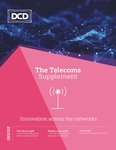APIs this, API that. It was impossible to attend a telecoms event last year and not hear APIs mentioned by mobile carriers and vendors.
Application Programming Interfaces (APIs) are a software intermediary that allows two applications to talk to each other. They are an accessible way to extract and share data within and across organizations, and are deployed for tasks from booking an Uber to sending a mobile payment.
But beyond this, they’re also seen as a big potential money maker for the telecoms sector, at a time when making money from expensive network rollouts has been a challenge.
McKinsey & Company estimates that the network API market could unlock around $100 billion to $300 billion in connectivity and Edge-computing related revenue for mobile carriers over the next five to seven years.
Operators are hoping that they can utilize APIs to sell additional services to their customers, and potentially create new revenue streams through new use cases, while network vendors see an opportunity to help these carriers play off of this platform.
"The revenue opportunity created by mobile network APIs is forecast to grow to over $20 billion by 2028,” Joakim Sorelius, head of global network platform, product, and engineering at Ericsson, said last year.
“As connectivity becomes ever more integral, network APIs are emerging as a highly anticipated means for telcos to instantly monetize their 5G investment.”
Indeed Ericsson, via Vonage, has been one of the biggest advocates for APIs.
“We are trying to make it easier to connect all the different operators and make more globally accessible APIs available so you can have better observability on the networks,” Magnus Frodigh, VP and head of research, Ericsson, told DCD last year.
The Swedish network manufacturer acquired cloud communications company Vonage in 2022 for about $6.2 billion.
Nothing new
But APIs haven’t sprung up overnight.
“Telcos have tried to monetize APIs for a long time, but a lot of their early attempts haven't really scaled,” says Darius Singh, director, consulting and enterprise platforms lead, STL Partners. “We would say they've been markedly unsuccessful.”
But he says the landscape is now different from that which telcos faced in the past, with the maturing cloud market meaning that fresh opportunities have opened up for carriers.
“When the operators tried this before, there were not as prevailing cloud and cloud environments for enterprise customers and developers,”
Singh says. “It was certainly not as mature as it is now.” Singh also points out another reason APIs have become so important for carriers, explaining that industry collaboration is playing more of a role.
Doug Makishima, CEO of communications technology vendor VieQi, and also an advisor to and program director for MEF, points out that there’s been a significant industry push to standardize APIs.
“APIs have been around a long time but the reach has been limited,” Makishima says. Extending this reach will be key to making APIs more lucrative.
“For anything to be successful in our Internet and app-based world, it has to be ubiquitous, and you have to have reach,” Makishima argues. “There has to be standardization, and before APIs were proprietary. So by definition, you're not going to achieve scale and reach like this.”
Makishima formerly worked for the GSMA, and says the organization’s launch of its open gateway initiative, which aims to make the most out of APIs, has been a good thing for the industry. The Linux Foundation’s Camara Project has similar goals, he adds.
Vendors going big on APIs
In September, Ericsson, along with a dozen telcos - América Móvil, AT&T, Bharti Airtel, Deutsche Telekom, Orange, Reliance Jio, Singtel, Telefonica, Telstra, T-Mobile, Verizon, and Vodafone - announced a new venture to combine and sell network APIs on a global scale to “spur innovation in digital services.”
The venture, which has since been named Aduna, is 50 percent owned by Ericsson, with the remaining half split between the other carriers.
Ericsson’s CEO Börje Ekholm stated at the time that the venture would drive innovation and growth for everyone.
Singh expects the margins for vendors such as Ericsson and Nokia to be relatively small, but says the move to push APIs will enable them to help carrier partners generate revenue.
“I think what they [network vendors] want to do is if they get telcos more comfortable with monetizing their 5G network, the telcos are more likely to invest in refreshes and in 6G, because if telcos are making no money from their existing investment, they are not going to continue to go back to Ericsson and Nokia to buy more kit,” he explains.
“I think Nokia and Ericsson also have to make this ecosystem happen, because otherwise telcos will say, ‘well, I invested in all these fancy 5G capabilities. I couldn't make any money from it, so why would I buy anything more advanced from you?’”
It’s not just Ericsson pushing APIs. Rival Nordic vendor Nokia is also banging the drum.
When asked last year if Nokia would join Ericsson’s API venture, Nokia’s CEO Pekka Lundmark appeared to rule out such a move.
"Everybody has been saying, including all these joint venture partners, that this will be a non-exclusive market, and we all need to do our best to accelerate the API economy. I do not believe at all that it would be a one-player-takes-it-all market."
Instead, the company has its own API strategy, and last year launched the Nokia Exposure Platform (NEP), which it says aims to expand and simplify the number of APIs available to operators, their partners, and customer channels.
Nokia has agreements in place with more than 50 partners, including telcos such as BT, Deutsche Telekom, Orange, Telefónica, and Telecom Argentina.
How are carriers using them?
There have been early examples of how mobile carriers are using network APIs.
Vodafone, one of the operators that is part of the venture, is using APIs to inform smartphone users who are calling them.
The service, which is being used by organizations such as banks, hospitals, and schools in Germany, is called CallerID, and it allows users to distinguish who exactly is calling them, meaning that users are able to have greater awareness around anonymous phone calls.
Meanwhile, other operators such as Orange have used APIs to tackle fraud prevention and provide location services.
Makishima says that on top of monetization opportunities for carriers, there’s a chance for carriers to shift their strategy beyond just being a telco.
“From an operator perspective APIs can offer more value, unlock more value, and offer services. There’s also the holy grail of becoming a service provider again, instead of just a pipe,” he says, explaining that NaaS opens up the functionality of the network beyond what has previously been available.
Because of this, telcos can become a true service provider again, he says, “instead of just offering plans with unlimited all-you-can-eat data,” to their customers.
Monetization
It’s no secret that mobile carriers have struggled to generate the revenues expected from technologies such as 5G, which many critics say has yet to deliver a killer app or particular use case.
Singh suggests that the pressure on telcos has possibly played a role in the industry’s approach to how it views APIs.
“There's a sense of ‘well we got to monetize all the investment we've made somehow. Can network APIs can be the thing that helped us monetize?’” he says.
“There’s a big shift towards Network as a Service (NaaS), and even the shift towards network slicing and on-demand technology, and so I think APIs get bucketed into that. The shift towards NaaS is seen as a big opportunity to try and take a new role and to sell connectivity in a new way.”
Frodigh acknowledges that 5G has failed to translate into the growth that was expected for the industry, but is bullish about APIs providing a substantial monetization opportunity.
“It's just slower than that we hoped for,” says Frodigh on the landscape of the 5G era. “So, we are trying to work on this monetization. We're trying to make it easier to use the technology. So we are trying to offer more advanced APIs to the market, so you can have developers using these technologies and offer these new services, whatever they would like to invent.”
Optimism
Makishima is hopeful that carriers are headed in the right direction with how they utilize APIs.
He’s confident that the right boxes are being ticked and that with a continued collaborative approach from the industry so that remaining obstacles will be cleared.
Singh is also optimistic that telcos will maximize APIs, and expects Ericsson and Nokia to make more noise this year. He does, however, warn that revenue might not be imminent.
“Scaling APIs is a big platform play. You need to onboard all of these developers. It's more about adoption rates and less about revenues in the first few years,” says Singh.
With telcos under pressure to generate more money for shareholders, only time will tell if APIs can help recover some much-needed return on investment.




